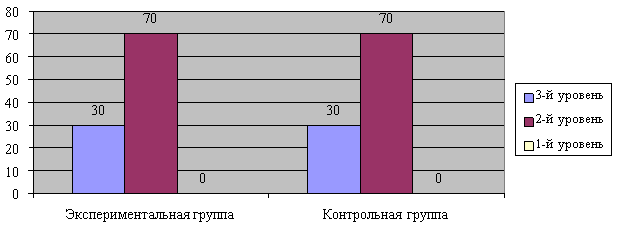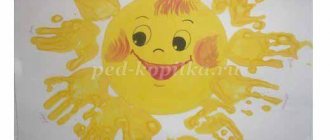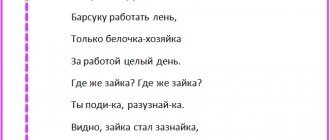The role of fiction in the development of coherent speech in children of senior preschool age
The article provides an analysis of the results of diagnosing the level of formation of coherent speech in children of senior preschool age. Since fiction is accessible to the understanding of children older than preschool age, at the formative stage, thematic planning for the month was developed based on a model of a set of activities for the development of coherent speech.
Key words : speech, fiction, older preschoolers, coherent speech, fiction, speech development.
In accordance with the Federal State Educational Standard for Preschool Education and the “Concept of Preschool Education,” the basis of education and training in preschool childhood is speech acquisition. This document notes that preschool childhood is especially sensitive to speech acquisition, and if a certain level of mastery of the native language is not achieved by 5–6 years, then this path, as a rule, cannot be successfully completed at later age stages.
The purpose of the study is to theoretically substantiate and practically prove the effectiveness of developing coherent speech through fiction.
40 children of senior preschool age took part in the study (20 experimental, 20 control group).
To determine the role of fiction in the development of coherent speech in children of senior preschool age, we carried out experimental work, which consisted of three stages:
1. Ascertaining stage.
Purpose: to determine the level of development of coherent speech in preschool children.
To diagnose coherent speech in preschool children, we used the technique of V. N. Makarova [3, p. 6].
he Task: retell the text in as much detail as possible. The examination revealed the children’s ability to retell an unfamiliar text (V. Suteev’s story “Under the Mushroom”).
Rice. 1. Distribution of indicators by level of text reproduction among older preschoolers at the ascertaining stage of the experiment
Based on the survey results, in the experimental group 5% (1 child) of preschoolers were identified with a high level of figurative text reproduction, while in the control group 15% (3 children) were identified. A group of preschool children from the experimental group (4 people) and 10% of preschool children from the control group (2 people) were identified who did not cope with the task and were unable to independently reproduce the text. 75% of preschoolers in the experimental and control groups (15 people) completed the task at an average level: the experimenter’s help and leading questions contributed to the reproduction of the text, the children were able to formulate the main idea only the second time.
As a result, it was revealed that 20% of preschoolers in the experimental group (4 people) and 10% of preschoolers in the control group (2 people) found it difficult to reproduce the text and had difficulty formulating the meaning of the text.
From the analysis of the results it is clear that there is an inability to convey content due to an insufficient, poor vocabulary. Independent utterances are characterized by unnecessary pauses, conversational cliches, and distortion of the sound structure of words.
Children found it difficult to compose a story, even if they had stimulus pictures; many needed help from adults in the form of leading questions and word prompts.
Analysis of the results indicates the following errors in children: when moving from one part to another, there was no connecting element, a sharp jump. Multiple agrammatisms were observed in the narrative.
All children partially composed a story of 3 parts; unintentional expansions or contractions of the plot were noted. When composing a story, children mainly use simple sentences and form them incorrectly.
The results of the study of older preschoolers allowed us to develop and test classes on the development of coherent speech through fiction.
2. Formative stage.
Goal: development of coherent speech through fiction in older preschoolers.
In the second paragraph of the second chapter (the formative stage of the study), we described the stages of the formation of coherent speech in older preschoolers through fiction.
The development of coherent speech in older preschoolers was carried out through reading and discussing such classical works as:
“The Scarlet Flower” by S. Aksakov, Russian folk tales “The Snow Maiden” and “Nikita Kozhemyaka”, “The Mysterious Disappearance of the Goose” by V. Suteev, “Fox Bread” by M. Prishvin, “Four Wishes” by K. Ushinsky.
Thus, when studying fiction, children learned:
- build your statements coherently;
– use figurative language;
– replenished and developed vocabulary.
3. Control stage.
Purpose: to determine the dynamics in the development of coherent speech in preschoolers after the formative stage through fiction. At this stage, we described the results of a study conducted using the same method by V. N. Makarova.

Rice. 2. Distribution of indicators by level of text reproduction among older preschoolers at the control stage of the experiment
From the analysis of the results, it is clear that preschoolers in the experimental group have an increase in their ability to reproduce the content of the text they heard. The number of children who were able to independently formulate the main idea of a text and easily reproduce the text they had listened to increased by 25% in the experimental group and by 15% in the control group.
There were no children left who could not cope with the task, which indicates positive dynamics and correctly chosen corrective measures.
The number of children with an average level in the control and experimental groups decreased by 5%.
Thus, having examined 2 samples of preschoolers, we came to the following conclusions: in the experimental group, the dynamics of the development of coherent speech are better, they have a decrease in the number of logical errors, there is no “getting stuck” on minor details, the main events come to the fore of the narrative when composing a story based on a series of plot paintings.
Thus, the results of the control experiment indicate positive dynamics.
Literature:
- Alekseeva M. M., Yashina V. I. Methods of speech development and teaching the native language of preschoolers: Textbook. aid for students avg. ped. textbook Establishments / M. M. Alekseeva, V. I. Yashina. - M.: Academy, 2017. - 400c.
- Gerbova V.V. Lesson on speech development in the senior group of kindergarten / V.V. Gerbova. - M.: Svet, 20144. - 94 p.
- Makarova V. N., Stavtseva E. A., Edakova M. N. Diagnosis of speech development in preschool children: Methodological manual / V. N. Makarova, E. A. Stavtseva, M. N. Edakova. - M.: Pedagogical Society of Russia, 2014. - 80 p.
- Ushakova O.S., Strunina E. Methods for identifying the level of speech development of children. - M.: Education, 2015. - 200 p.
- Fedorenko L. P., Fomicheva G. A., Lotarev V. K. Methods of speech development for preschool children / L. P. Fedorenko, G. A. Fomicheva, V. K. Lotarev. - M.: Academy, 2013. - 90 p.
MAGAZINE Preschooler.RF
“Development of coherent speech in preschool children through exposure to fiction and theatrical activities”“Reading books is the path along which a skillful, intelligent, thinking teacher finds the way to a child’s heart” V.A. Sukhomlinsky.
“The theater is a magical world. He gives lessons in beauty, morality and ethics. And the richer they are, the more successful the development of the spiritual world of children is...” B. M. Teplov
Theatrical activities and reading fiction purposefully influence the activation and development of a number of mental processes, such as perception, memory, imagination, thinking. They are closely related to the formation of children's oral communication skills. If you include theatrical games and reading fiction every day in all forms of the pedagogical process, you can improve the degree of speech development of children.
Work in speech therapy groups in this area is carried out in three areas:
- Creation of a subject-developing environment (book corner, theater corner)
- Work with children.
- Working with parents.
Work with children:
To familiarize ourselves with fiction, our groups carry out the following work:
- Every day in the first half of the day - telling fairy tales, in the afternoon - reading fiction.
- Articulation gymnastics, physical education sessions, and finger exercises are performed every day.
- Every evening there are games in the theater corner.
- Independent activity of children in the book corner (examining illustrations for books)
- A project was also developed: “Cooperation between kindergarten and library”
“The main task of an adult is to discover the reader’s talent in a child” S.Ya. Marshak
In November, my children and I visited the library named after. V. G. Belinsky. The event was dedicated to Mother's Day .
The following work is carried out on theatrical activities in our groups:
- Every Friday children perform a performance based on a fairy tale
- Mutual attendance at performances
- Joint production of attributes for organizing theatrical games
Theatrical activities and reading fiction are among the most effective ways to develop speech. Here the creative abilities of children are manifested, as well as the activity in which the principle of learning is most clearly manifested: learning by playing.
With the help of theatrical activities, you can solve almost all the problems of the speech development program. Captivated by the attractive concept of a theatrical production, a child learns a lot and learns how the skills acquired in theatrical play can be used in everyday life.
| Next > |



